Latest Contributions
Read More Contributions
Cricket memories: Aussies were ‘Lakered’ in 1956
Category:
Tags:

Subhash Mathur is a resident of Jaipur, after his superannuation from the Indian Revenue Service in 2007. Presently, Subhash is engaged in social and charitable work in rural areas. Subhash is also Editor of http://www.inourdays.org/, an online portal for preserving work-related memories.
My earliest memory of International cricket goes back to 1956. At that point of time, I was living in Bikaner, where my father, Shri Khemchand, was posted as Collector & District Magistrate upon transfer from Jhalawar.
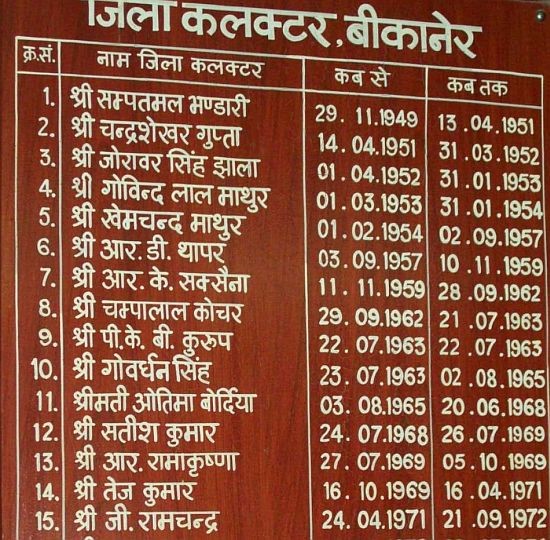
List of Bikaner Collectors, starting November 1949. My father was the fifth Collector of Bikaner, from February 1954 to September 1957.
We used to live in the huge bungalow earmarked for the Collector of the District. The same bungalow is being used by the Collector at present also.
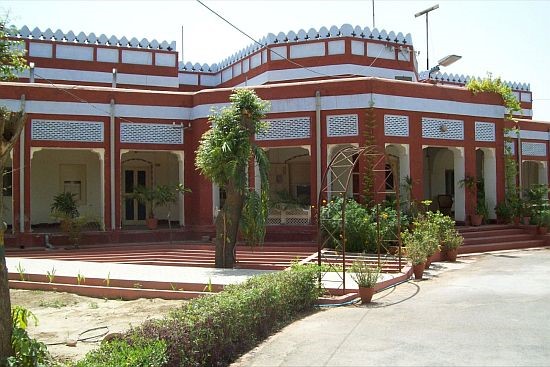
Collector’s Residence, Bikaner. Photo is recent but looked the same in the 1950s.
The most significant part of the house was the kitchen, which was nearly 50 or so feet away. To reach the kitchen one had to traverse a long corridor with the left side covered with a green wooden trellis. And on the right were the pantry rooms, largely vacant. It was the old-fashioned coal-fired chuhla, which was started with the help of wood. One had to sit down to cook curries and rotis.
Outside the trellis gallery and along the kitchen corridor, we had prepared a concrete cement half-pitch for enjoying ‘home’ cricket. As cricket balls were expensive and we were always short on funds, our hugely lovable Dadi Laxmi Devi used to come to our rescue. Dadi helped us out by stitching cloth balls from chindis – straps of discarded cloth. (Yes, that’s right. Our cricket ball was a home-made cotton ball)! She would sit in the verandah, and enjoy watching us play, with joy written all over her face.
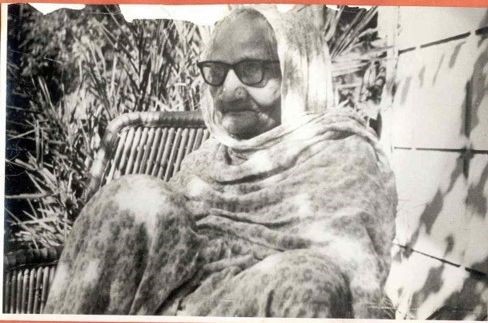
My Dadi Laxmi Devi. Jaipur. Late 1970s.
These multi-layered tightly knit balls picked up not only pace off the pitch but also gave plenty of bounce. That’s how we learnt to fend off bouncers all our lives.
Naturally the cricket genes have passed on to the next two generations as well. Whenever my grandchildren assemble in Jaipur we play cricket with gusto and pride.
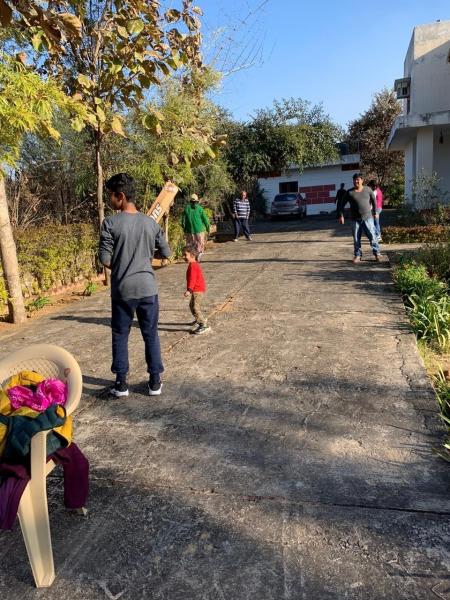
December 2019
My son Gaurav bowling, his son Saksham batting and grandson Aarav fielding. Grandma Tilak in Green jacket returning to base. Subhash in strategic position for the return catch.
Nature Farms, Jaipur.
The summer of 1956 was a ‘Game-changing’ moment in my life. I started reading English newspapers. That also meant that I started following International cricket matches? The newspapers from Delhi used to come one or two days late, we did not have a radio at home, and TV was unknown in India. So what? The excitement came through!
And, even though I had only a hazy idea of anything about Australia, I became internationally oriented even as I was living in what was a small, remote city that was far away even from Jaipur and Delhi. Thanks to cricket.
In those days, English dailies covered sports in two full pages. One page was devoted to international sports and events. Local sporting events were covered on page two. Photos of players in different poses were published liberally.
In the summer of 1956, Australia was touring England to wrest the Ashes from England. They came armed with a strong team.
Big name players like classy Neil Harvey, openers Colin McDonald and Jim Burke all-rounders, Keith Miller and Richie Benaud were part of the Australian side. Pacers Ray Lindwall, Ron Archer and Alan Davidson formed the quartet along with Keith Miller. Maddocks was their keeper and Ken Mackay was their utility man like Trevor Bailey of England or the Indian Bapu Nadkarni.
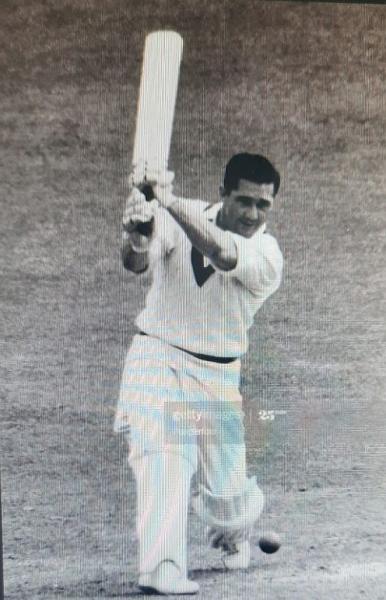
Neil Harvey, left-handed Aussie batsman.
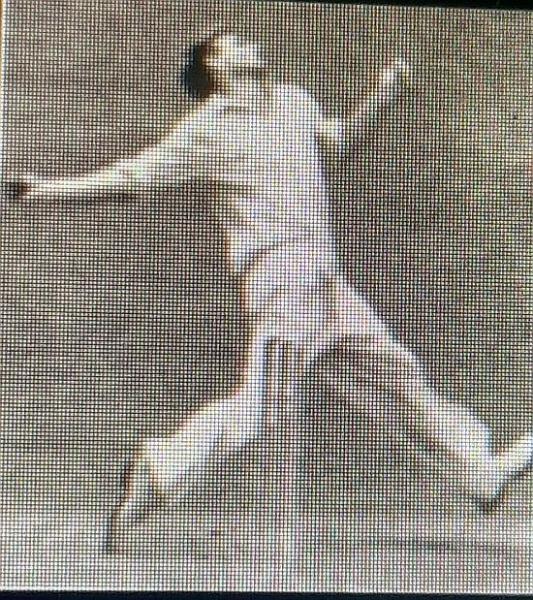
Ray Lindwall, Aussie pace bowler.
The Aussie team’s captain was the not-so-popular Ian Johnson. Miller felt that he deserved to be the captain.
England’s captain was Peter May, a cover drive specialist. The series featured batting specialists like Colin Cowdrey, Tom Graveny, Dennis Compton and a priest, Rev DS Sheppard, perhaps the only ordained priest to play international cricket.
The English pace bowling attack was spearheaded by the fearsome Freddie Truman who was ably supported by ‘wicket to wicket ‘specialist Brian Statham. The nagging accuracy of Statham later on became Glenn McGrath hallmark: who occupied just outside the off-stump territory.
In Evans, England had a more than a capable wicket-keeper batsman. He was a’ spotter’ and a valuable guide to Captain Peter May.
But the trump card for England and their ‘wrecker in chief’ turned out to none of the above but Jim Laker, the magician.
By the end of the fifth Test the press had labeled the series as ‘Aussies Lakered.’
Laker created a record that stands even today unmatched and untouched: 19 wickets in a Test match.
In the fourth Test at Manchester, Laker picked up nine Aussie wickets including clean bowling Aussie mainstay Harvey for a naught. Locke spoiled Laker’s party by picking up Jim Burke in the first innings.
But there was no stopping Laker in the second innings. This time Laker ensured that all wickets were snared by him alone. Laker created a unique world record of picking up all ten wickets in a Test innings for the first time ever.
Laker again removed Harvey for a Golden duck. Thus, the Truman, Statham, Laker and Locke combo demolished an accomplished Australian side, which had landed on the English shores with much hope and lots of aspirations.

Jim Laker, England’s spin bowler, leading his team back to the pavilion after drubbing Australia. 1950s
Left-hander Neil Harvey till date continues to be my all time favourite. And I rate Richie Benaud as the best all - rounder Captain, just a step behind Sir Gary Sobers.
Several decades later in 1999 Kumble matched Laker’s ten-wicket haul. They share this distinction jointly now.
Laker ended the five Test series with 46 wickets. An astonishing feat for a spinner. Yet, Laker is a relatively unknown name in cricketing circles these days.
Of course, England retained the Ashes 2-1 but my interest in the cricketing world was fired up and it continues to enthrall me even now today on an going basis.
I was able to convert my passion for cricket in real terms as well. I was the opening pace bowler played for my school, St. Xavier’s, Jaipur as their opening bowler, and later on for Rajasthan College, Jaipur. See https://www.indiaofthepasorg/c-v-vaidynathan-and-subhash-mathur/life-bac....
I was privileged to be part of the College team along with ‘Test player in the making‘ Parathasarthy Sharma.
Since then, my cricket world revolved around the Ashes tours and exploits of the 3 Ws: Weeks, Worrell, and Walcott followed by Sobers, Kanhai, Hall and Griffith .
I also followed the exploits of the South African greats McGlew, McLean, Tayfield, Barlow, Proctor and senior Pollock.
Those days the Indian team was a ‘rare' win’ side. But players like Vinoo Mankad and Vijay Merchant gladdened the hearts of the Indian fans with some outstanding performances.
From the first tied Test in 1961, the competition between Australia and West Indies also became intense and competitive. I became a keen follower of those matches as well.
Before I close out, I must make a mention of a few super commentators of that era: names of John Arlott Jack Bannister, EW Swanton, Vizzy, and Dicky Rutnagur (newspapers – see https://tinyurl.com/29w8ktbm) come to my mind readily. There was no TV, but we could see the match and the excitement over the radio!
And Umpire Dickie Bird.
Over the decades playing conditions have changed much: pitches began to be covered, helmets became mandatory, TV umpires became important, many changes in no ball rule, DRS or the referral procedure introduced, match referees appointed, day night test matches with pink balls have started. And many more are in the offing.
Have these changes made cricket more engrossing? More entertaining? More watchable?
The jury is still out.
____________________________________
© Subhash Mathur. Published February 2021.
Comments
Blog on cricket by Subhash Mathur
your observations Prakash ji
Add new comment